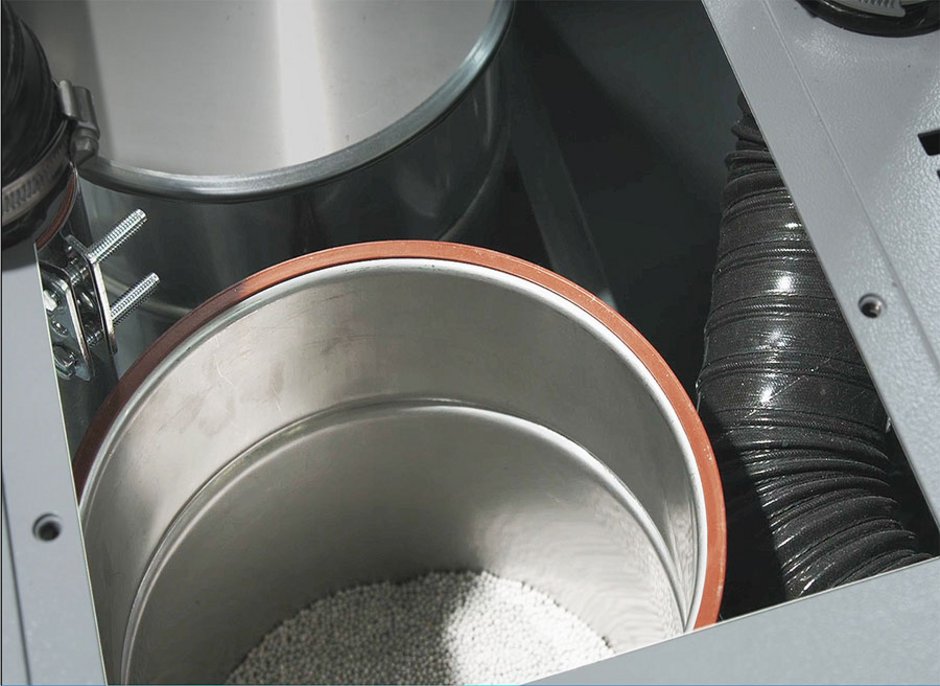55 - Can automatic air flow regulation save energy?

The comparison of traditional drying systems with more modern versions illustrates many approaches to saving energy. Particularly air flow regulation, possibly combined with lower temperatures, as well as the use of heat exchangers for regeneration and high temperature applications are valuable additional devices in this context.
The total energy consumption of drying is composed of the energy requirements of the following individual components:
- Process heater
- Regeneration of the desiccant
- Blower
- Cooling the return air (optional)
Additionally, energy consumption is significantly influenced by the following material parameters:
- Material intake and target temperatures
- Material intake and target final moisture content
- Throughput
- Type of material
These parameters of a drying system are also relevant for energy consumption:
- Dry air flow
- Type of regeneration
- Return air temperature
- Heat reclaiming systems
- Heat losses
Increased consumption of drying systems with conventional engineering and technology can effect energy consumption in all areas. The reason for this is that drying systems are designed in such a way that target values need to be achieved even under the worst possible conditions. As soon as parameters such as initial moisture, intake temperature or material throughput are „improved“, energy consumption can theoretically be reduced. For systems without air flow regulation, however, too much air then flows through the drying bin. This has a direct effect on the power consumption of the bin heater, which uses more energy than required to heat.
Additionally, air flow regulation can directly reduce power consumption in summer due to the warmer material intake temperatures. This means that in summer power consumption can be reduced by up to 25%.
There are of course other ways to reduce energy consumption, for example with a reduced throughput due to production conditions or at weekends, when production is reduced. With air flow regulation the air flow can then be reduced to 40%, resulting in significantly lower energy consumption.
Normally, power consumption of the blower is at 60% of the connection power. If the air flow of the process blower is reduced using air flow regulation, the power consumption of the blower is also reduced. In this context, an important aspect plays a deciding role: the pressure drag in the air lines increases exponentially with the air flow speed. This also means that, if the air flow is reduced with lower blower rotation speeds, the power consumption decreases exponentially. At the same time, the entire power system of the drying system is relieved. Because of reduced air flow, any leaks in the line systems have less of an impact, as less environmental air can enter the drying system as the pressure differences are smaller, resulting simultaneously in less moisture being adsorbed by the molecular sieve.
If the system operates with a simple regeneration method and without dew point control, the molecular sieve is regenerated in a fixed time cycle. The actual state of the molecular sieve doesn’t play a role.
For optimised regeneration methods, on the other hand, only the energy actually needed for regeneration is used. Additionally, a heat exchanger in the regeneration heating cycle can further reduce heating energy consumption by up to 25%.
Example comparison of certain parameters for a conventional and a regulated drying system for 5 materials
- ABS: 45 kg/h
- ABS: 40 kg/h
- PA 6: 60 kg/h
- PC / Disc: 50 kg/h
- PSU: 25 kg/h
- Required heating energy at worst conditions: 5,55 kW
- Calculated air requirements: 380 m³
- Chosen dryer: 400 m³ air consumption
- Necessary dehumidifying power: max. ca. 1000 g/h
| conventional | regulated | |
| dry air requirement | variable up to 380 m³ | variable up to 380 m³ |
| dry air production | always 400 m³ | requirement-dependent 120-380 m³ |
| regeneration cycles | time-dependent every 3 h | requirement-dependent ca. every 4.4 h |
| heating energy consumption | ca. 6 kW | requirement-dependent ca. 2.2 – 6 kW |
| energy consumption blower | constant 2,2 kW | requirement-dependent 0.7-2.2 kW |
| return air temperature | dependent on throughput | nearly consistent |
| heat exchanger regeneration | no | yes, up to 25% energy savings / cycle |
| energy consumption at reduced throughput | remains the same | is reduced |
You want to save energy while drying? Find the right equipment on www.motan.com
